Pavo constellation lies in the southern sky. Its name means “the peacock” in Latin.
The constellation was introduced by the Dutch astronomer Petrus Plancius from the observations of Dutch navigators Frederick de Houtman and Pieter Dirkszoon Keyser in the late 16th century. Pavo was first depicted in 1598 on Plancius’ globe and first appeared in a star atlas in 1603, in Johann Bayer’s Uranometria.
In Australia, a part of the constellation is known as “the Saucepan” and used as a guide to finding the south. Pavo is notable for its bright star Peacock, the nearby solar analog Delta Pavonis, the interacting galaxies NGC 6872 (the Condor Galaxy) and IC 4970, and several other deep sky objects.
Facts, location and map
Pavo is the 44th constellation in size, occupying an area of 378 square degrees. It is located in the fourth quadrant of the southern hemisphere (SQ4) and can be seen at latitudes between +30° and -90°. The neighboring constellations are Apus, Ara, Indus, Octans and Telescopium.
The constellation name Pavo is pronounced /ˈpeɪvoʊ/. In English, the constellation is known as the Peacock. The genitive form of Pavo, used in star names, is Pavonis (pronunciation: /pəˈvoʊnɪs/). The three-letter abbreviation, adopted by the International Astronomical Union (IAU) in 1922, is Pav.
Pavo belongs to the Johann Bayer family of constellations, along with Apus, Chamaeleon, Dorado, Grus, Hydrus, Indus, Musca, Phoenix, Tucana and Volans.
Pavo contains five stars with confirmed planets and has no Messier objects. The brightest star in the constellation is Peacock, Alpha Pavonis, with an apparent magnitude of 1.94. There is one meteor shower associated with the constellation: the Delta Pavonids.
Pavo contains one named star. The star name approved by the International Astronomical Union (IAU) is Peacock.
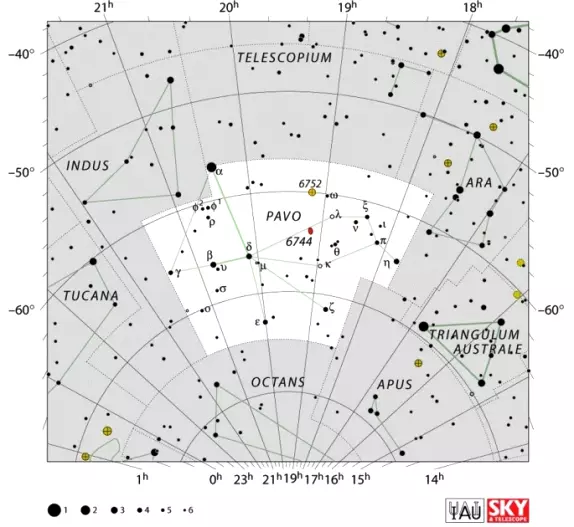
Pavo constellation map by IAU and Sky&Telescope magazine
Myth
The constellation is believed to represent the Java green peacock which the Dutch navigators de Houtman and Keyser probably encountered on their journey to the East Indies.
In Greek mythology, the peacock was Hera’s sacred bird. The goddess drove through the air in a chariot drawn by peacocks. There is a myth specifically associated with the peacock’s tail and how it came to have eyes on it.
When Zeus fell in love with Io, a nymph and priestess of Hera in Argos, he turned her into a cow to hide her from Hera when the goddess almost caught the two. Hera was suspicious nonetheless and tasked the giant Argus with keeping an eye on the heifer. Argus had a hundred eyes, which made him an excellent guard. (He is also sometimes known as Argus Panoptes, the epithet Panoptes meaning “all seeing.”)
Argus tied Io to an olive tree in Nemea, and Zeus dispatched Hermes to free the nymph from the giant. Hermes obliged and came to Earth disguised as a shepherd. He spent a day telling Argus stories and playing reed pipes until all of Argus’ eyes became tired. When the giant fell asleep, Hermes hit him with a stone. To honour Argus’ memory, Hera placed his eyes on her sacred bird’s tail.
Major stars in Pavo
Peacock – α Pavonis (Alpha Pavonis)
Alpha Pavonis is the brightest star in Pavo. It is located near the border with the constellation Telescopium. The star has an apparent magnitude of 1.94 and is approximately 179 light years distant from Earth.
Alpha Pavonis is a blue-white subgiant star belonging to the spectral class B2 IV. It is a spectroscopic binary with an orbital period of 11.753 days. Since the stars in the binary system cannot be resolved, the companion’s stellar classification is unknown.
The name Peacock was given to the star by Her Majesty’s Nautical Almanac Office in the late 1930s. HMNAO, which is now part of the United Kingdom Hydrographic Office, produces astronomical data and publishes the Nautical Almanac. They assigned the name Peacock to Alpha Pavonis when they created the Air Almanac, a navigational guide for the Royal Air Force, which included 57 bright stars. Only two of them did not have proper names at the time: Alpha Pavonis and Epsilon Carinae in the constellation Carina. The RAF insisted that all the stars in the almanac have names, so Alpha Pavonis was named Peacock, after the constellation, and Epsilon Carinae got the name Avior.
Peacock has six times the Sun’s mass and 5-6 times the solar radius. It is 2,200 times more luminous than the Sun.
β Pavonis (Beta Pavonis)
Beta Pavonis is the second brightest star in the constellation. It has a visual magnitude of 3.42 and is approximately 137 light years distant. It is a subgiant star belonging to the spectral class A5IV. It is 58 times more luminous than the Sun and has 3.8 times the solar radius.
δ Pavonis (Delta Pavonis)
Delta Pavonis is one of the nearest bright stars to the Sun. It is only 19.92 light years distant and has an apparent magnitude of 3.56. The star can be seen without binoculars from the southern hemisphere.
Delta Pavonis is a subgiant star with the stellar classification G8 IV. It is 22% more luminous than the Sun, slightly less massive with 99.1% of the Sun’s mass, and 122% of the solar radius. Its age is estimated to be between 6.6 and 6.9 billion years.
The star has a 214% abundance of iron in its atmosphere compared to the Sun, which sometimes indicates the presence of a planet in a star’s orbit. None have been discovered yet, however.
Delta Pavonis was identified as the “Best SETI (search for extraterrestrial intelligence) target” of the 100 nearest G-class stars by Maggie Turnbull and Jill Tarter or the SETI Institute. It is the nearest solar analog that is not part of a binary or multiple star system.
γ Pavonis (Gamma Pavonis)
Gamma Pavonis is a main sequence star belonging to the spectral class F9 V. It has an apparent magnitude of 4.22 and is 30.21 light years distant.
The star has a 15% larger radius and 21% greater mass than the Sun. It is 152% more luminous.
Gamma Pavonis is ranked 14th on the Terrestial Planet Finder’s top 100 target stars to search for a planet similar to ours located in the star’s Habitable Zone.
φ2 Pavonis (Phi-2 Pavonis, HD 196378)
Phi-2 Pavonis is a dwarf star, yellow-white in colour and belonging to the spectral class F8V. It has an apparent magnitude of 5.12 and is 81.6 light years distant from Earth. The star is currently in the process of evolving into a subgiant.
HD 181433
HD 181433 is somewhere between being a red giant and a subgiant. It has the stellar classification K3III-IV and is approximately 87 light years distant. With an apparent magnitude of 8.38, the star cannot be seen without a telescope. In 2008, three extrasolar planets were discovered orbiting the star.
Deep sky objects in Pavo
NGC 6752
NGC 6752 is a globular cluster. It is the third brightest globular star cluster in the night sky, fainter only than 47 Tucanae (NGC 104) in the constellation Tucana and Omega Centauri (NGC 5139) in Centaurus.
The cluster has an apparent magnitude of 5.4 and is about 13,000 light years distant from the solar system.
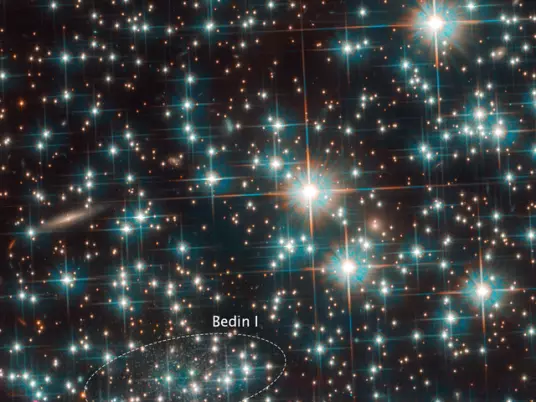
This is a Hubble Space Telescope image of a concentration of stars within the globular cluster NGC 6752. Hidden among the stars is an image of a background galaxy that is much farther away. The diminutive galaxy, named by its discoverers as Bedin 1, measures only around 3,000 light-years at its greatest extent — a fraction of the size of the Milky Way. Not only is it tiny, but it is also incredibly faint. These properties led astronomers to classify it as a dwarf spheroidal galaxy that is as old as the universe. Image: NASA, ESA, and L. Bedin (Astronomical Observatory of Padua, Italy)
NGC 6872 and IC 4970
NGC 6872 (the Condor Galaxy) and IC 4970 are a pair of interacting galaxies in Pavo. They have an apparent magnitude of 12.7 and 14.7 and are approximately 220 million light years distant from the solar system.
IC 4970 is a type E7-S0 elliptical galaxy. NGC 6872 is the larger galaxy of the two. It is a barred spiral galaxy in shaped like an integral sign. It has one significantly disrupted spiral arm which is home to many young blue stars. The starburst activity in the region is believed to have been caused by IC 4970 recently passing through it.
NGC 6872 is one of the largest barred spiral galaxies known. It extends across almost 380,000 light years.
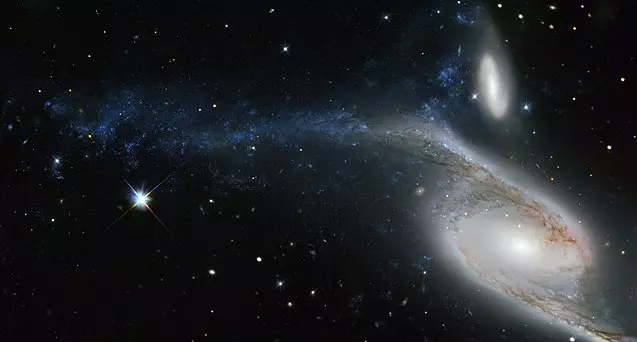
This picture, taken by the NASA/ESA Hubble Space Telescope’s Wide Field Planetary Camera 2 (WFPC2), shows a galaxy known as NGC 6872 in the constellation of Pavo (The Peacock). Its unusual shape is caused by its interactions with the smaller galaxy that can be seen just above NGC 6872, called IC 4970. They both lie roughly 300 million light-years away from Earth. Image: ESA/Hubble & NASA, acknowledgement: Judy Schmidt
NGC 6744 (Caldwell 101)
NGC 6744 is an intermediate spiral galaxy in Pavo. It has an apparent magnitude of 9.14 and is approximately 31 million light years distant. It is one of the most similar nearby galaxies to the Milky Way.
NGC 6744 has at least one satellite galaxy, the distorted NGC 6744A, which bears a passing resemblance to one of the Magellanic Clouds, irregular dwarf galaxies in the Local Group.
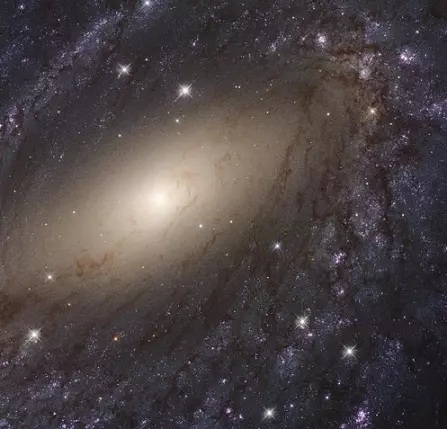
Like more than two-thirds of the known galaxies in the universe, Caldwell 101 has a spiral shape. It stretches far beyond the edges of this Hubble view, more than 200,000 light-years across in all. Larger than our own Milky Way galaxy, it is one of the relatively few large spiral galaxies in the neighboring universe. Besides its larger size, this galaxy is very similar to the Milky Way. In fact, if there are observers somewhere in this sibling galaxy looking back at the Milky Way, they might see a very similar image — looking at Caldwell 101 is almost like seeing the Milky Way’s reflection in a giant, intergalactic mirror.
Also cataloged as NGC 6744, Caldwell 101 is similar to our home galaxy in more ways than one. Like the Milky Way, its yellowish core is dominated by the light from old, cool stars. Stretching outward from the elongated core are spiral arms that are littered with dust, which goes hand-in-hand with star formation. In this Hubble image, taken in visible and ultraviolet light with the Wide Field Camera 3, colorful regions encircle the center of the giant galaxy. While the blue sites are full of young star clusters, the pink ones are regions of active star formation. Image: NASA, ESA and the LEGUS team
IC 4687, IC 4689, IC 4687/6, AM 1809-574
IC 4687, IC 4689, and IC 4686, are a triplet of interacting and merging galaxies in Pavo constellation. They are located approximately 250 million light years distant from the solar system.
IC 4687 has a chaotic disk of stars and deformed spiral arms as a result of the collision with its neighbours. IC 4686 has a very bright nucleus, and IC 4689 has a distinct hook.
The three galaxies will eventually merge into one giant galaxy, but for now they are home to many starburst regions, which appear as glowing blue patches and are formed of millions hot, young blue stars.
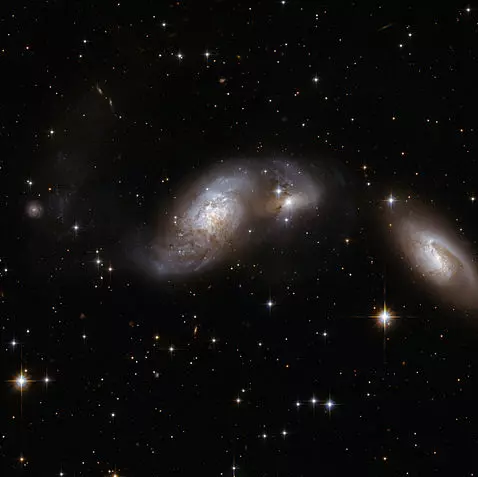
IC 4687 forms a triplet with two other galaxies: IC 4686 to the right and IC 4689 further to the right. IC 4687 has a chaotic body of stars, gas and dust and a large curly tail to the left. The two companions are partially obscured by dark bands of dust. The interacting triplet is about 250 million light-years away from Earth, in the constellation of Pavo, the Peacock. Image: NASA, ESA, the Hubble Heritage (STScI/AURA)-ESA/Hubble Collaboration, and A. Evans (University of Virginia, Charlottesville/NRAO/Stony Brook University)
NGC 6782
NGC 6782 is a barred spiral galaxy in Pavo. It has a visual magnitude of 11.8 and is approximately 183 million light years distant.
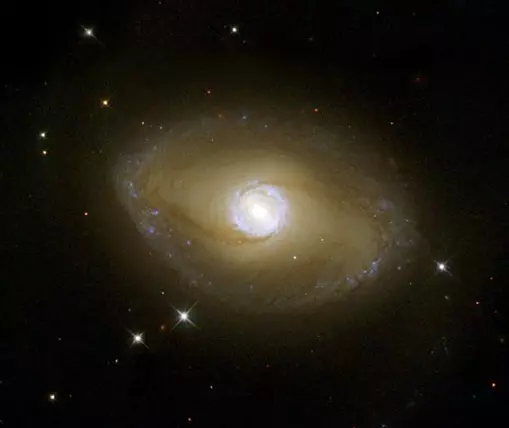
NGC 6782, image: NASA and The Hubble Heritage Team (STScI/AURA)